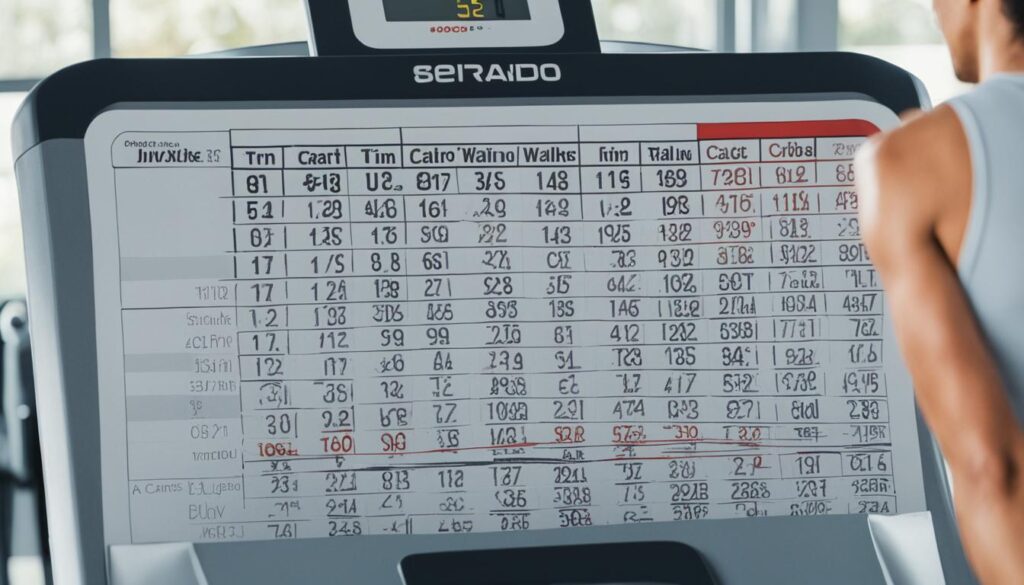When it comes to achieving maximum fat burning, cardio workouts are the way to go. Not only do they help shed those extra pounds, but they also improve heart health, boost metabolism, and increase stamina. Whether you’re looking to lose weight or maintain a healthy lifestyle, incorporating cardio exercises into your fitness routine is essential.
Cardio exercises are known for their ability to burn calories and fat. They elevate the heart rate, which in turn increases the body’s calorie expenditure. This process aids in weight loss and helps maintain a healthy weight. Additionally, cardio workouts have numerous health benefits, including reducing the risk of diabetes, high blood pressure, and stroke.
There are various types of cardio exercises that can help you achieve maximum fat burning. From high-intensity interval training (HIIT) to running, walking, cycling, and more, there is a wide range of options to suit different fitness levels and preferences. The key is to find an exercise that you enjoy and can stick to consistently.
Key Takeaways:
- Cardio workouts are effective for maximum fat burning.
- They improve heart health and prevent conditions like diabetes and high blood pressure.
- High-intensity interval training (HIIT), running, walking, cycling, and stair climbing are some of the best cardio exercises for weight loss.
- Engaging in regular cardio workouts can lead to improved stamina, increased energy, and a better overall quality of life.
- Incorporate cardio exercises into your fitness routine for optimal fat burning and weight management.
The Best Cardio Exercises for Weight Loss
When it comes to weight loss, incorporating cardio workouts into your fitness routine is essential. Cardio exercises not only help burn calories but also improve cardiovascular fitness and offer a range of health benefits. Here are some of the best cardio workouts for weight loss:
1. High-Intensity Interval Training (HIIT)
High-intensity interval training, or HIIT, involves short bursts of intense exercise followed by short recovery periods. This type of training is highly effective for burning fat and calories, boosting metabolism, and improving endurance. It can be performed with various exercises such as sprints, jumping jacks, or burpees.
2. Stair Climber
Using a stair climber machine is a great way to engage the muscles in your lower body while getting an effective cardiovascular workout. It targets your glutes, thighs, and calves, helping to build strength and endurance. The intensity can be adjusted to suit your fitness level, making it suitable for beginners and advanced exercisers alike.
3. Running
Running is a classic cardio exercise that requires minimal equipment and can be done anywhere. It burns a high number of calories, improves cardiovascular health, strengthens leg muscles, and helps maintain a healthy weight. Whether you prefer outdoor running or treadmill workouts, running is an excellent choice for weight loss.
4. Walking
If you’re new to exercise or have joint issues, walking is a low-impact cardio workout that can still provide significant weight loss benefits. Brisk walking raises your heart rate, increases calorie burn, and improves cardiovascular fitness. Aim to walk for at least 30 minutes a day, five days a week, to reap the full benefits.
5. Cycling
Indoor or outdoor cycling is an effective cardio exercise that targets your leg muscles, burns calories, and improves cardiovascular endurance. Cycling can be done on a stationary bike at the gym, a spin class, or even outdoors on a regular bicycle. It’s a versatile workout option that can be adjusted to different intensity levels.
6. Sprinting
Add some sprint intervals to your cardio routine for an extra fat-burning boost. Sprinting involves short bursts of maximum effort running followed by recovery periods. This high-intensity exercise not only burns calories during the workout but also increases your metabolic rate, helping you burn more calories throughout the day.
7. Elliptical
The elliptical machine provides a low-impact cardio workout that is easy on the joints while still providing an effective calorie burn. It targets multiple muscle groups, including the legs, arms, and core. The elliptical offers various resistance and incline settings to challenge different fitness levels.
8. Jump Rope
Jumping rope is a fun and effective cardio exercise that can be done anywhere. It engages multiple muscle groups, including the arms, shoulders, legs, and core. Jumping rope improves cardiovascular fitness, burns calories rapidly, and helps develop coordination and agility.
These cardio exercises are highly effective for weight loss and improving overall fitness. Incorporate them into your fitness routine to burn calories, boost metabolism, and achieve your weight loss goals.
High-Intensity Interval Training (HIIT)

If you’re looking for an efficient and effective way to burn fat and improve your fitness level, High-Intensity Interval Training (HIIT) is the way to go. HIIT workouts involve alternating between short bursts of high-intensity activity and periods of rest or low-intensity exercise. This type of training has gained popularity for its ability to maximize calorie burn and accelerate metabolism.
HIIT workouts are known for their time-saving benefits, as they can be completed in a shorter duration compared to traditional steady-state cardio exercises. Despite the shorter duration, HIIT is highly effective for burning fat and improving cardiovascular fitness.
During a HIIT workout, the intensity challenges your body, increasing your heart rate and causing you to work harder. This leads to greater calorie expenditure during the workout and even after, as your body continues to burn calories to recover and repair.
HIIT also offers a range of health benefits, such as improved cardiovascular function, increased endurance, and better management of diabetes. Research has shown that HIIT can improve insulin sensitivity and help regulate blood sugar levels.
One of the major advantages of HIIT is its versatility. You can incorporate a variety of exercises into your HIIT routine, allowing you to choose the activities that you enjoy and that target the specific muscle groups you want to work on. Whether it’s sprinting, cycling, bodyweight exercises, or a combination of different exercises, there are endless possibilities when it comes to HIIT workouts.
Benefits of HIIT:
- Accelerates fat burning and boosts metabolism
- Improves cardiovascular health and endurance
- Enhances insulin sensitivity and manages diabetes
- Increases overall fitness level and performance
- Can be customized to suit individual fitness levels and goals
- Requires minimal equipment and can be done anywhere
With its high intensity and quick results, it’s no wonder that HIIT has become one of the most popular forms of exercise for fat loss and overall fitness. So, if you’re ready to take your workouts to the next level and maximize your fat-burning potential, give HIIT a try!
| Exercise | Calories Burned per 30 Minutes (approx.) |
|---|---|
| Running | 400-500 |
| Cycling | 300-400 |
| Jumping Rope | 300-400 |
| Stair Climber | 300-400 |
Stair Climber: A Powerful Fat-Burning Exercise
When it comes to effective fat-burning exercises, the stair climber is a true standout (see my post here). This low-impact cardio workout engages the entire body, delivering exceptional results for weight loss and overall fitness. Whether you’re a beginner or an advanced exerciser, the stair climber can be tailored to suit your individual fitness level.
The stair climber specifically targets leg endurance and helps build cardiovascular fitness, making it an excellent choice for those looking to shed unwanted pounds. By mimicking the action of climbing stairs, this exercise activates major muscle groups in the lower body, including the glutes, quadriceps, hamstrings, and calves.
What sets the stair climber apart from other cardio machines is its ability to provide a rigorous workout with minimal impact on the joints. This makes it a suitable option for individuals with knee or joint issues who still want to engage in high-intensity fat-burning exercises (check this post out).
One of the great advantages of the stair climber is its versatility. By adjusting the speed and intensity, you can customize your workout to match your desired level of challenge. Up the intensity for a high-intensity interval training (HIIT) session or dial it back for a steady-state climb. Either way, you’ll be torching calories, ramping up your metabolism, and working towards your weight loss goals.
“The stair climber provides an efficient, full-body workout that can help you burn calories and shed excess fat. It’s a fantastic option for anyone looking to improve their cardiovascular endurance and achieve their weight loss goals.”
If you’re ready to take your fat-burning efforts to the next level, incorporate the stair climber into your fitness routine. Challenge yourself and reap the rewards of this powerful, yet low-impact exercise.
Running

Running is a highly effective fat burning exercise that offers a wide range of health benefits. Whether you’re a beginner or an experienced runner, this form of cardio exercise can be tailored to suit your fitness level. Here are some of the key advantages of running:
Burns Fat
Running is one of the best exercises for burning fat. It is a high-intensity activity that engages multiple muscle groups, resulting in significant calorie burn. The more intense the run, the more calories you will burn, making it an excellent choice for weight loss and maintaining a healthy weight.
Strengthens Muscles
In addition to burning fat, running also helps strengthen muscles throughout your body. It primarily targets the lower body, including the quadriceps, hamstrings, calves, and glutes. Regular running can lead to toned and defined leg muscles, improving overall strength and power.
Improves Cardiovascular Health
Running is a cardiovascular exercise that elevates your heart rate, improves lung capacity, and enhances overall cardiovascular fitness. Regular running sessions can help reduce the risk of heart disease, lower blood pressure, and improve cholesterol levels. It strengthens the heart, making it more efficient at pumping blood and oxygen throughout the body.
Boosts Mood
Running is not just beneficial for the body but also for the mind. It releases endorphins, also known as “feel-good” hormones, which can help boost mood and reduce stress. Many runners find that a good run can improve mental clarity, promote relaxation, and enhance overall well-being.
Helps Maintain a Healthy Weight
Running is an effective tool for weight management. By combining calorie burning with muscle strengthening, running can help you shed excess weight and maintain a healthy body composition. It also increases your metabolic rate, meaning you continue to burn calories even after your run is complete.
The ability to run is one of the greatest gifts we have as humans. Embrace it, use it, and always be grateful for it. – Anonymous
| Running Intensity | Calories Burned (per 30 minutes) |
|---|---|
| Light Jog (5 mph) | 240-320 calories |
| Moderate Pace (6 mph) | 295-372 calories |
| Fast Pace (8 mph) | 416-563 calories |
As shown in the table, the intensity at which you run has a direct impact on the number of calories burned. It is important to adjust your running pace according to your goals and fitness level.
Running is a versatile exercise that can be done indoors on a treadmill or outdoors in various terrains. Remember to warm up before each run and gradually increase the intensity and duration over time to avoid injuries. With consistency and proper form, running can become a rewarding and enjoyable part of your fitness routine.
Walking

Walking is an easy and low-impact workout that is suitable for everyone. Whether you’re looking to lose weight or simply improve your overall fitness, brisk walking is a great option. Not only does it help burn calories, but it also offers a multitude of health benefits.
One of the key advantages of walking is its ability to aid in weight loss. By engaging in regular walking sessions, you can effectively burn fat and shed those extra pounds. Additionally, walking at a brisk pace can help increase your heart rate and boost your metabolism, allowing you to continue burning calories even after your workout.
Walking is a natural form of exercise that can be easily incorporated into your daily routine. It doesn’t require any special equipment or training, making it accessible to people of all fitness levels. Plus, it’s a great way to enjoy the outdoors and explore your surroundings.
Aside from its fat-burning benefits, walking also provides various health advantages. It can significantly reduce the risk of heart disease, diabetes, and stroke, making it an excellent exercise choice for cardiovascular health. Walking regularly can also help improve cholesterol levels and lower blood pressure.
Moreover, walking has positive effects on mental health. Engaging in regular walks outdoors can boost your mood, reduce stress levels, and enhance overall well-being. It’s a simple and enjoyable activity that allows you to clear your mind and connect with nature.
To get the most out of your walking routine, aim for at least 30 minutes of brisk walking every day. You can gradually increase your pace and duration as your fitness level improves. Remember to wear comfortable shoes and maintain proper posture throughout your walk.
Incorporating walking into your fitness routine can be a game-changer. It not only helps with weight loss but also provides a wide range of health benefits, from reducing the risk of heart disease and diabetes to improving cholesterol levels and boosting mental health. So lace up your sneakers and start walking your way to a healthier and fitter lifestyle!
Cycling

When it comes to fat burning exercises, cycling is a fantastic option that offers a range of benefits for both weight loss and overall fitness. Not only is cycling a low-impact exercise, but it also helps improve cardiovascular health, strengthens bones, and tones abdominal muscles.
Whether you prefer cycling outdoors or on stationary bikes at the gym, this activity can be easily incorporated into your regular workout routine. It provides an excellent cardiovascular workout that increases your heart rate, helping to burn calories and shed excess body fat.
One of the advantages of cycling is that it can be adapted to suit various fitness levels. You can start with leisurely rides before gradually increasing the intensity and duration of your cycling sessions. This flexibility makes it a suitable exercise for beginners as well as experienced athletes looking to improve their fitness levels.
Incorporating cycling into your routine is not only beneficial for weight loss but also contributes to improved mental well-being. Cycling outdoors allows you to enjoy the scenery and fresh air, which can help reduce stress levels and improve mood.
The Benefits of Cycling
Cycling has numerous health benefits, including:
- Improved cardiovascular health
- Enhanced leg strength and endurance
- Toned abdominal muscles
- Increased stamina and energy levels
- Reduced risk of chronic diseases, such as heart disease and diabetes
- Weight management
Cycling is a versatile exercise that can be enjoyed by people of all ages and fitness levels. Whether you’re cycling for transportation, leisure, or as part of a structured workout, this activity is a great way to burn fat, improve your fitness, and achieve your weight loss goals.
Sprinting

Sprinting is a powerful and dynamic form of high-intensity interval training (HIIT) that combines bursts of intense speed with short recovery periods. It is an excellent cardiovascular exercise that helps improve speed, agility, and overall fitness.
During sprinting, you push your body to its limits by running at maximum effort for short intervals, typically ranging from 10 to 30 seconds. These intense bursts of speed challenge your muscles and cardiovascular system, leading to improved endurance and performance.
Sprinting can be customized to suit your individual fitness level and goals. Whether you’re a beginner looking to increase your speed or an experienced athlete aiming to enhance your athletic performance, sprinting can be tailored to meet your specific needs.
The Benefits of Sprinting
Sprinting offers a range of benefits that go beyond cardiovascular fitness. Here are some key advantages:
- Improved Speed and Power: Sprinting helps you develop explosive speed and power, which can be beneficial for various sports and activities.
- Enhanced Agility and Coordination: Regular sprinting workouts improve agility and coordination, making you more agile and responsive in everyday movements.
- Increased Calorie Burn: High-intensity sprinting burns a significant amount of calories in a short period. This can aid in weight loss and weight maintenance.
- Boosted Metabolism: Sprinting stimulates your metabolism, leading to increased calorie burn even after your workout.
- Time-Efficient: Sprinting is a time-efficient exercise option, as you can achieve significant benefits in a shorter amount of time compared to longer, steady-state cardio workouts.
Tips for Sprinting Safely
While sprinting can be an incredibly effective workout, it’s essential to approach it with caution to prevent injury. Here are a few tips to keep in mind:
- Warm up thoroughly before sprinting to prepare your muscles and joints for the intense activity.
- Start with shorter sprint intervals and gradually increase the duration and intensity as your fitness level improves.
- Listen to your body and rest when needed. Overtraining can lead to injuries and hinder your progress.
- Choose a flat, safe surface for sprinting, free from obstacles or hazards.
- Invest in proper footwear with good support and cushioning to protect your feet and minimize the risk of injuries.
If you’re new to sprinting or have any underlying health conditions, it’s always a good idea to consult with a healthcare professional or certified fitness trainer before starting a sprinting routine.
| Benefits of Sprinting | How to Achieve |
|---|---|
| Improves speed and power | Push your limits during sprint intervals |
| Enhances agility and coordination | Focus on quick movements and change of direction |
| Increases calorie burn | Perform high-intensity sprints for maximum effort |
| Boosts metabolism | Include sprinting workouts in your routine |
| Time-efficient | Achieve significant benefits in a shorter amount of time |
Elliptical

When it comes to low-impact cardio workouts, the elliptical machine takes center stage. This versatile piece of equipment offers a safe and effective exercise option for individuals with knee or joint issues. The elliptical motion provides a smooth and fluid movement that reduces stress on the joints, making it an ideal alternative to high-impact activities like running on a treadmill.
Not only does the elliptical provide a low-impact workout, but it also offers a range of cardiovascular benefits. By engaging both the upper and lower body, it effectively works multiple muscle groups while increasing heart rate and improving cardiovascular fitness. Whether you’re a beginner or a seasoned fitness enthusiast, the elliptical can be tailored to suit individual fitness levels and goals.
One of the advantages of using an elliptical machine is the ability to customize your workout. Most ellipticals allow you to adjust the resistance level, incline, and even incorporate interval training. This versatility keeps your workouts challenging and helps prevent plateaus, ensuring continuous progress towards your fitness goals.
If you’re looking for an effective way to burn calories and improve cardiovascular health without putting excessive strain on your joints, the elliptical machine is an excellent choice. Incorporating it into your fitness routine can help you achieve your weight loss goals while minimizing the risk of injury.
Jump Rope

Jumping rope is a fun and effective cardio exercise that engages both the upper and lower body muscles while burning calories. It is a fantastic workout for weight loss and overall fitness. Incorporating jump rope into your exercise routine can help you achieve your fat burning goals.
- Improves cardiovascular fitness and stamina
- Enhances coordination and balance
- Tones and strengthens leg muscles, including calves and quads
- Works the core muscles, including abs and obliques
- Helps in shedding excess body fat and achieving a lean physique
This versatile exercise can be done almost anywhere and requires minimal equipment. It is suitable for people of all fitness levels, from beginners to advanced athletes. To make your jump rope workout more challenging, try different techniques like double-unders or alternating foot patterns.
Jump Rope Techniques
Here are some jump rope techniques you can incorporate into your routine:
- Basic Jump: Jump with both feet together, swinging the rope underneath your body.
- Single-Leg Jump: Lift one leg off the ground while jumping with the other leg, alternating between legs.
- Side-to-Side Jump: Jump from side to side, crossing the rope in front of your body.
- Criss-Cross: Jump with your feet crossed at the ankles, uncrossing them on the next jump.
“Jumping rope is a high-intensity exercise that effectively burns calories and improves cardiovascular fitness.” – Fitness Expert
Remember to start with a warm-up and gradually increase the intensity and duration of your jump rope sessions. It is essential to maintain proper form and listen to your body to avoid injuries.
| Jump Rope Duration | Calories Burned | Difficulty Level |
|---|---|---|
| 15 minutes | 150-200 calories | Beginner |
| 30 minutes | 300-400 calories | Intermediate |
| 45 minutes | 450-600 calories | Advanced |
Benefits of Cardio Exercise

Engaging in regular cardiovascular exercises offers a multitude of benefits that significantly contribute to overall health and well-being. Whether you’re aiming to reduce the risk of chronic diseases or improve your fitness level, incorporating cardio workouts into your routine can yield remarkable results.
Reducing the Risk of Health Problems
- Diabetes: Cardio exercises help regulate blood sugar levels and improve insulin sensitivity, reducing the risk of developing type 2 diabetes.
- High Blood Pressure: Regular cardiovascular workouts are effective in lowering blood pressure, thereby reducing the risk of hypertension.
- Heart Disease and Stroke: By improving heart health, cardio exercises help prevent the onset of cardiovascular diseases and reduce the risk of stroke.
- Obesity: Cardiovascular activities play a crucial role in weight management and can aid in achieving and maintaining a healthy weight, reducing the risk of obesity.
Improving Physical Fitness
- Heart health: Cardio exercises strengthen the heart muscle, improving its efficiency and reducing the risk of heart-related ailments.
- Strength and Stamina: Regular cardio workouts help build endurance and increase overall physical strength, allowing you to perform daily tasks with ease.
- Lung and Muscle Fitness: By improving lung capacity and muscle tone, cardiovascular exercises enhance overall respiratory function and promote lean muscle development.
Enhancing Mood and Well-being
Engaging in cardio exercises releases endorphins, which are natural mood elevators, leading to increased feelings of happiness and well-being. Regular cardiovascular workouts can also help alleviate symptoms of depression and anxiety, leading to improved mental health.
So, whether you choose running, cycling, jump rope, or any other cardiovascular activity, prioritize adding consistent cardio exercise into your routine. The benefits are far-reaching, from reducing the risk of chronic diseases to improving overall fitness and enhancing your mood.
Conclusion
Including cardio exercises in your fitness routine is crucial for weight loss, overall health, and fitness. The key to maximum fat burning lies in engaging in the best cardio exercises. These include high-intensity interval training (HIIT), the stair climber, running, walking, cycling, sprinting, the elliptical, and jump rope.
Regular cardio workouts offer a multitude of benefits. They improve heart health, aiding in the prevention of chronic conditions such as diabetes, high blood pressure, and stroke. Cardio exercises are also highly effective for weight management, helping you shed excess pounds or maintain a healthy weight.
Engaging in aerobic exercises not only helps you achieve your weight loss goals but also increases your energy levels and enhances your overall quality of life. By incorporating these workouts into your routine, you can experience improved cardiovascular fitness, increased stamina, and endurance.
So, whether you choose to incorporate HIIT, running, walking, cycling, or any other form of cardio exercise, you can take steps towards a healthier, fitter, and more vibrant life. Start your cardio training for weight loss today and unlock the potential for a better future.




